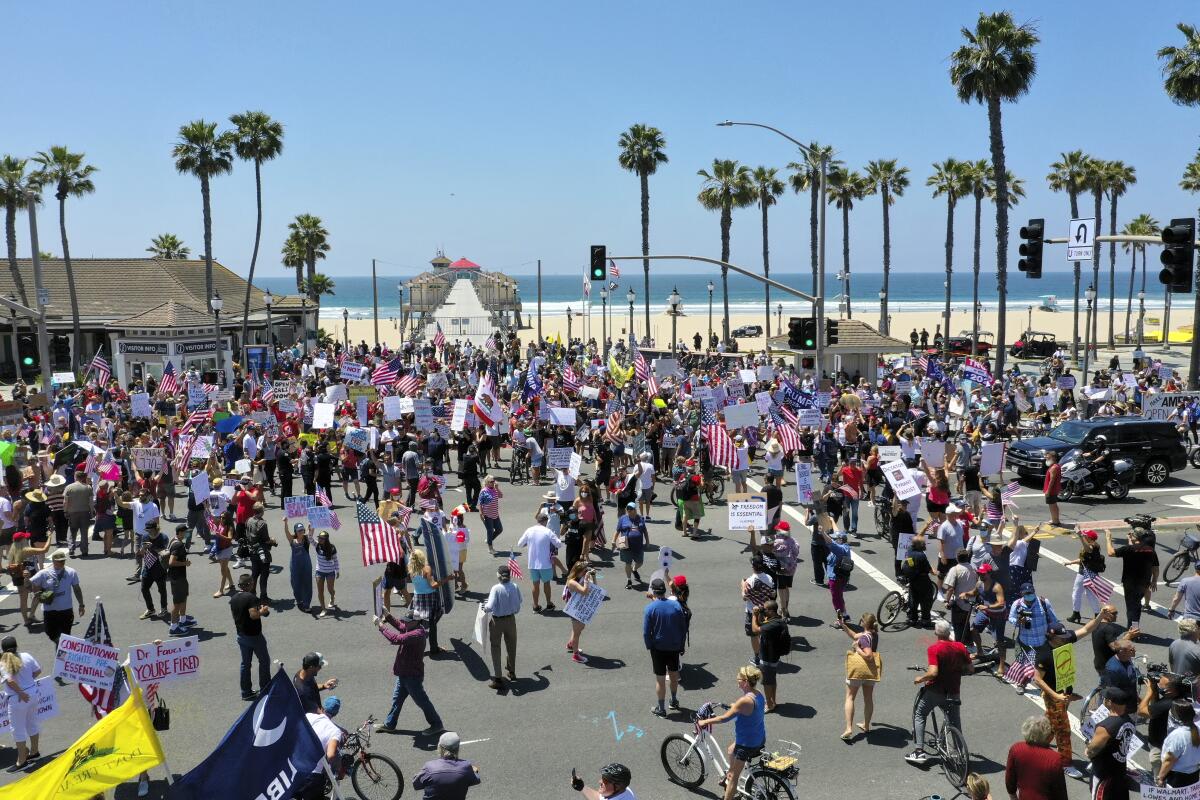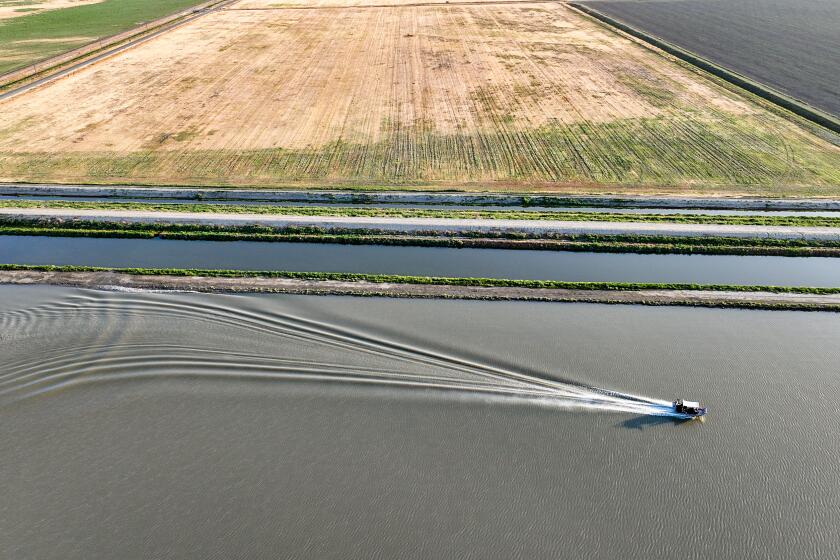Boiling Point: Why climate change matters more than ever during the coronavirus pandemic

Environmental factors including deforestation, air pollution and urbanization contribute to the severity of pandemics like COVID-19. Experts warn that if we continue to destroy the environment, future pandemics could become more common.
Welcome to the first edition of Boiling Point, a newsletter about climate change, energy and the environment in California and the American West. I’m Sammy Roth, a reporter for the Los Angeles Times, and each week I’ll help you navigate the news and understand how it might affect your life, your community and the landscapes you love.
It’s possible you’re wondering: Why start this newsletter during a devastating pandemic? I’ll offer two reasons.
First, the coronavirus helps to expose some of the dangers posed by a rapidly warming planet.
My colleague Tony Barboza wrote recently about research showing that Americans living in areas with worse air pollution are at greater risk of dying from COVID-19. And as the Arizona Republic’s Amanda Morris reported in March, climate change and habitat destruction can make animals more susceptible to infectious diseases, while also bringing them into closer contact with humans.
In other words, human actions are creating a world where a contagion like the coronavirus is more likely to spread. And lung-damaging air pollution from fossil fuels may be making it harder for people to fight off this type of virus.
The second reason is that climate change hasn’t stopped just because so many of us are sheltering in place.
Researchers at Carbon Brief say 2020 is shaping up to be one of the hottest years on record. Meanwhile, drought conditions in Northern California may prompt an early start to this year’s wildfire season, as my colleague Paul Duginski reports.
Toward a more sustainable California
Get Boiling Point, our newsletter exploring climate change, energy and the environment, and become part of the conversation — and the solution.
You may occasionally receive promotional content from the Los Angeles Times.
And the world is still burning plenty of planet-warming fossil fuel, even with oil demand crashing and crude prices briefly falling below zero.
There will always be people who say it’s the wrong time to talk about carbon emissions, or water pollution, or the extinction crisis. They’ll say economic growth must come first, and hopefully we can fix the environment later. I’m hearing those voices loud and clear right now, especially with millions of people suddenly out of work.
But if you ask me — and if you’re reading this newsletter, you’re probably at least curious what I think — the COVID-19 pandemic actually makes it more important, not less, to keep climate change discussions front and center.
As a society and as individuals, we’ve got all sorts of consequential decisions to make in the coming months. Will policymakers choose to rebuild the country’s battered economy by investing in clean-energy jobs, an idea I’ve written about? Will Americans choose to fly less than they did before the coronavirus, continuing a trend that has seen carbon-intensive air travel plunge?
And will world leaders begin to take seriously the warnings of scientists, a critical step both for confronting climate change and for preventing future pandemics?
If it’s not clear by now, I care deeply about this stuff. Like many of you, I’m worried about what the climate crisis means for me personally: for California, the state I’ve called home my entire life; for the desert trails and wilderness areas where I learned to love hiking; and for my friends and family across the country who are threatened by worsening wildfires, storms and floods.
In other words: We’re in this together.
Here’s what’s happening this week:
TOP STORIES
The coronavirus could make summer heat waves more deadly. Like climate change, the virus disproportionately harms people who are already vulnerable — and experts worry we’ll see more of that this summer, when the pandemic may collide with heat waves made worse by rising temperatures. Anna M. Phillips and Tony Barboza of The Times report that older and low-income Americans may be stuck at home this summer without air conditioning — or without the financial means to pay for it.
A SoCalGas union leader derailed a local climate vote by threatening to bus in hundreds of protesters “potentially adding to this pandemic.” I’ve written a lot about California’s efforts to phase out fossil natural gas — and the vigorous pushback from Southern California Gas Co. But I was still stunned to discover a recent email from the leader of a SoCalGas-backed advocacy group threatening a mass protest in San Luis Obispo. “There will be no social distancing,” he told city officials. Here’s my story.

Fighting for beach access is a time-honored California tradition. The beach blockaders are usually wealthy property owners trying to keep regular people far away from their coastal retreats. But right now the ire is aimed at Gov. Gavin Newsom, and it’s coming from Californians who are tired of staying at home and want to spread their toes in the sand. Public health experts warn that crowded beaches could accelerate the spread of the coronavirus if people aren’t able to maintain social distancing.
Want to stay updated on which beaches are open, and what you’re allowed to do there? We’ve got a statewide tracker.
POWER STRUGGLES
Californians are scrambling to install solar panels and battery backups, to help keep the lights on during “Public Safety Power Shutoffs” designed to prevent wildfires. But COVID-19 is getting in the way. I wrote about local governments that have shut down their permit offices or are refusing to approve new solar installations — and about Pacific Gas & Electric, which for several weeks made it difficult for many customers to go solar, despite its own role in shutting off people’s electricity.
The pandemic is putting energy workers out of work. It’s true in Texas, where our Houston bureau chief, Molly Hennessy-Fiske, reports that the coronavirus and an oil price crash have resulted in thousands of layoffs; in the California city of Taft, which has been hit by a triple whammy of COVID-19, the oil slump and a prison closure, per The Times’ Susanne Rust and Carolyn Cole; and across the clean energy sector nationally, where 100,000 people filed for unemployment in March alone, as I wrote recently.
Should Los Angeles close some of its streets to make room for pedestrians? It’s a step that’s been taken by more than two dozen U.S. cities — including New York, Oakland, San Diego and San Francisco — to give people room to walk, run and bike during the pandemic. But in Los Angeles, elected officials have thus far balked at the concept, as Dakota Smith and Laura J. Nelson report for The Times. Even now, L.A.’s deeply ingrained car culture — which is a significant source of pollution — is tough to unravel.
Consider subscribing to The Times
Your support helps us deliver the news that matters most.
Become a Los Angeles Times subscriber.
SOMETHING IN THE AIR
You may remember seeing headlines in March about how clean Southern California’s air suddenly is, what with so many fewer cars on the road. But the sad reality, as Tony Barboza reports for The Times, is that our clean air streak has already come to an end as the weather gets drier and hotter. Smog’s quick return is a sobering reminder that air pollution and carbon emissions won’t be eliminated by lifestyle changes alone, and that larger structural changes to the economy will be needed.
Speaking of air quality, the American Lung Association came out with its annual rankings of the most polluted cities. As usual, California cities topped the lists for ozone and particle pollution. Here’s the view from San Diego, where smog levels are improving but still pretty bad; from Phoenix, where car and truck exhaust, wood-burning fireplaces and fireworks are major sources of pollution; and from Las Vegas, where officials are unhappy with the Lung Association over its grading system.
One more from Tony Barboza: The coronavirus outbreak is hampering enforcement of California’s air pollution rules. A halt to field inspections means “that an array of pollution sources, from soot-belching diesel trucks and cargo ships to methane-leaking landfills and oil and gas sites are undergoing far less scrutiny, at least on the ground, than is typical,” Tony writes.
AROUND THE WEST
A trickle of water is breathing life into the parched Colorado River Delta. I love this story from the Arizona Republic’s Ian James and Mark Henle, who took a trip to Mexico to see how environmental groups are using small amounts of water to restore wetlands and forests at the tail end of the Colorado River. The delta has been mostly dry for decades because city dwellers and farmers across the West — Angelenos included — have been consuming so much of the water that flows through the river.
A Trump administration nuclear plan could allow uranium mining bordering the Grand Canyon. Judy Fahys reports for InsideClimate News on a proposal from the White House Nuclear Fuel Working Group, which could result in the Grand Canyon’s northern and southern plateaus being opened to mining above the confluence of the Colorado and Little Colorado rivers.
“We the people of Montana grateful to God for the quiet beauty of our state, the grandeur of our mountains, the vastness of our rolling plains...” That’s the start of the preamble to Montana’s constitution — and potentially a key legal foundation for the 16 kids suing to stop the state from promoting fossil fuels. Here’s the story, once again from Judy Fahys at InsideClimate News.
What do you want to know?
When you think about California’s climate future, what keeps you up at night, and what gives you hope? What do you want to understand? What should I?
This newsletter is for you. I want to hear your questions, concerns and ideas. Email me or find me on Twitter.
ONE MORE THING
I’ve always been proud to work alongside Rosanna Xia, an all-star reporter who covers the California coast. This week I’m even prouder.
Rosanna was selected as a Pulitzer Prize finalist for her deeply reported story on the grim choices facing California as its beloved coastline disappears beneath a rising sea. If you haven’t read the piece, it’s still super relevant — and the powerful images of eroding bluffs and flooded seaside towns will stay with you. The Pulitzer folks also honored our colleagues Swetha Kannan and Terry Castleman, who built an eye-opening online game where you must try to save your town from the encroaching Pacific.
Congrats to Rosanna, Swetha and Terry. Congrats also to the staff of the Washington Post for winning the explanatory reporting Pulitzer for their series on the dire effects of climate change, from more intense fires in California to unbearable heat in Qatar.
I’ll be back in your inbox next week. If you enjoyed this newsletter, please consider forwarding it to your friends and colleagues.




